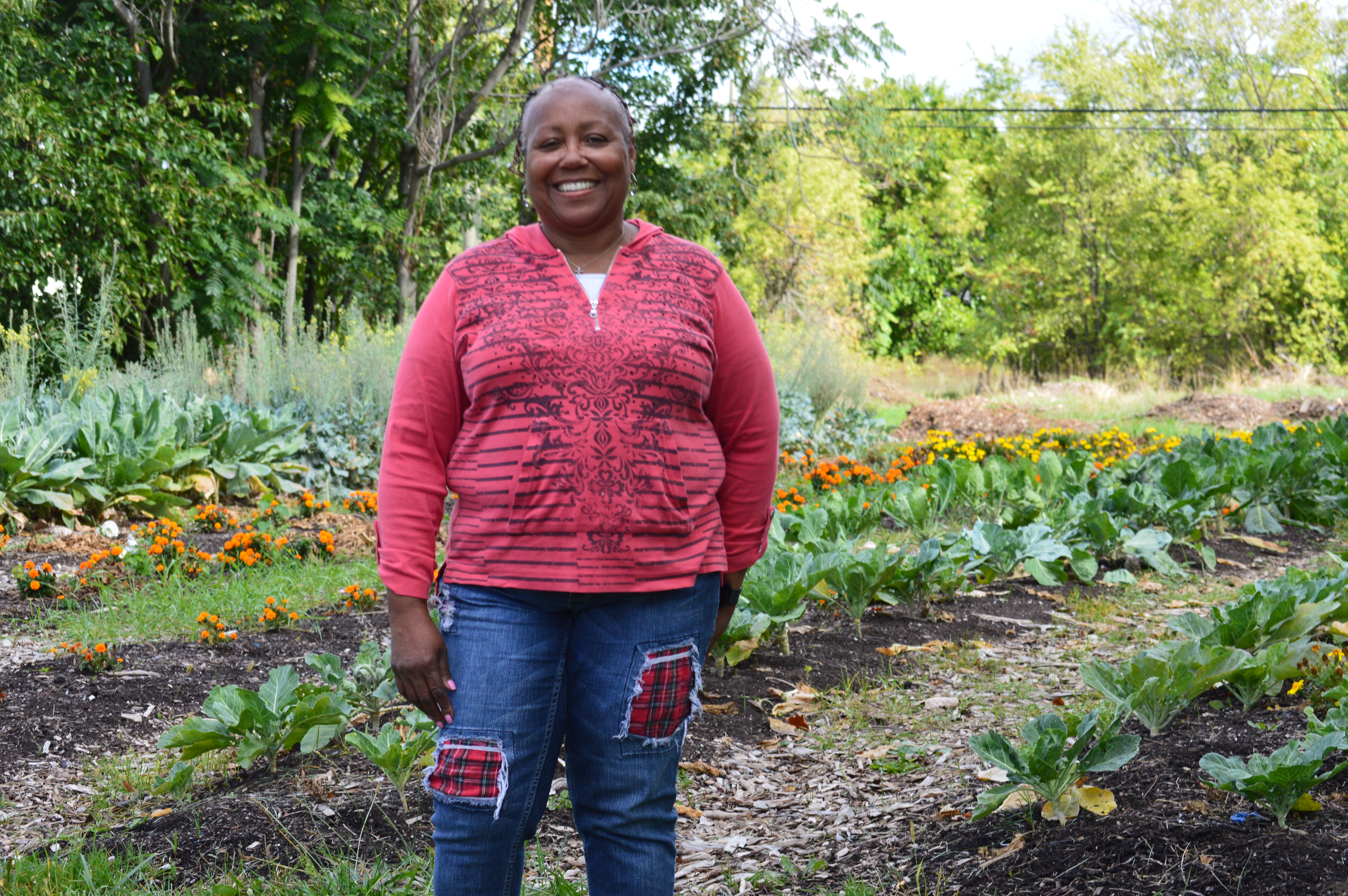
Jerry Hebron and her enthusiastic team are flipping the script, erasing despair, and replacing it with a heavy dose of self-determination.
In less than 10 years they have transformed a portion of the North End into innovative an landscape that could set the pattern for many Detroit neighborhoods.
Oakland Avenue Urban Farms located on the North End started in 2009 as a project derived from St. John Evangelist Temple of Truth and School of Wisdom, which is led by the Rev. Bertha L. Carter, Hebron’s mother. Carter challenged her congregation to provide food to area residents.
“The Oakland Avenue Urban Farms is a place where we are not only growing food, we cultivate youth, we cultivate art, we cultivate music, Hebron declared. “We truly cultivate much more than fruits and vegetables.”
What started as a 20-foot by 20-foot section of land has nestled next to the church has expanded to a full six acres on Oakland, Goodwin and Cameron streets on the North End about the size of five football fields. They call it Detroit Cultivator.
“The farm makes me feel good,” said Carlos Leonard, a team member. “I love making things grow and look beautiful, and seeing the progression of the farm helps me think about implementing growth in my personal life. I put my heart and soul into this work.”
Historic North End
The North End was once vibrant and bustling stores, homes of worship, and bars and clubs during the 1930’s, ‘40s, ‘50s and ‘60s. Originally part of Hamtramck Township, it was annexed by the City of Detroit in 1891. The community experienced a cultural and economic boom during the 1920s and 1930s as Detroit was the nation’s fourth largest city and its black population doubled from 149,000 in 1940 to 300,000 in 1950. Leading African Americans like Charles Roxborough, first black member of the Michigan senate, lived there on Chandler Street. So did drug store chain operator Sidney Barthwell, Alpha Kappa Alpha national president Beulah Whitby on Josephine Street and several recording artists including Smokey Robinson, the Four Tops, and Aretha Franklin.
“We had a rich night entertainment life, with Phelps Lounge, Apex, and all those places,” Hebron recalled. “Oakland Avenue was a thriving business district, and so it was like 24 hours, you can find whatever you want.”
But the community began to decline by the 1980s as disinvestment in Detroit increasingly became the trend. Blight set in. Planners suggest that 70 percent of the community’s building stock is gone. Its 2010 population of 31,603, according to census figures, represented a 31.3 percent decrease over 2000’s total of 46,010. Its number of households dipped from 17,550 in 2000 to 13,515 in 2010.
“The neighborhood became very decayed,” Hebron said. “High drugs, crime, you name it we had it. When I came back, it was a neighborhood that I didn’t know.”
Urban Revival
Hebron who had grew up going to church on Sundays in the North End organized about 25 people, including business owners and residents. They began to discuss what they would like to see. The team rallied, planned, and produced.
“So, we said, ‘Okay, let’s plant a garden,’” Hebron said.
She worried, however, about how to present an encore. She asked Dan Carmody from Eastern Market to visit the site and offer an assessment. Carmody assured Hebron that Oakland Avenue Urban Farm was special and that they should continue their effort.
“The problem for me in 2010 was seeing so many people, particularly black men walking up and down the street with no place to go,” Hebron said. “No place to go, nothing to do. It was kind of hopelessness, feeling invisible.”
She and other team members have joined the Michigan Farmer’s Market Association. Their vision is that OAUF will employ neighborhood residents.
“Afro Jam is our first value-added product,” Hebron said about their line of fruit preserves. “What we have done is begin to look at product incubation, so we’re on our campus, which started with the ten lots on Oakland, we’re now about four and half acres, five acres of land, so we’re on Oakland, Goodland and Cameron on the North End. We have various structures that we have identified for different things. One structure is our Afro Jam House. In that house we would be producing jam, preserves, canning classes, things like that.”
OAUF also has a youth component that is collecting oral histories of North End residents.
“We found the oldest living resident in the North End,” Hebron said. “She’s been here since 1923, she’s African American and 100 years old. We are starting with her story. It’s important that we capture her story, and that we memorialize it.”
OAUF has tapped into the Greening of Detroit for funding and technical support and along the way have attracted support from the W.K. Kellogg Foundation among others. It’s renovating an 8,500-square foot big box for events in a space that used to be a liquor store that hustled loosie cigarettes and expired meat; an artist studio in a 1,400-square foot home; and a design library in a 1,300-square foot home. Additionally, OAUF is the historic Red’s Jazz Shoe Shine Parlor as a hybrid commercial and event space.
“I am about people pooling together and helping and excelling with one another,” declared the Rev. Carter.”
For more information about Oakland Avenue Urban Farms see www.oaklandavenueurbanfarm.org, my personal email is jannhebron@gmail.com